Hepatitis C virus infection activates the immunologic (type II) isoform of nitric oxide synthase and thereby enhances DNA damage and mutations of cellular genes
- PMID: 15280491
- PMCID: PMC479064
- DOI: 10.1128/JVI.78.16.8835-8843.2004
Hepatitis C virus infection activates the immunologic (type II) isoform of nitric oxide synthase and thereby enhances DNA damage and mutations of cellular genes
Abstract
Hepatitis C virus (HCV) infection causes hepatitis, hepatocellular carcinoma, and B-cell lymphomas in a significant number of patients. Previously we have shown that HCV infection causes double-stranded DNA breaks and enhances the mutation frequency of cellular genes, including proto-oncogenes and immunoglobulin genes. To determine the mechanisms, we studied in vitro HCV infection of cell culture. Here we report that HCV infection activated the immunologic (type II) isoform of nitric oxide (NO) synthase (NOS), i.e., inducible NOS (iNOS), thereby inducing NO, which in turn induced DNA breaks and enhanced the mutation frequencies of cellular genes. Treatment of HCV-infected cells with NOS inhibitors or small interfering RNA specific for iNOS abolished most of these effects. Expression of the core protein or nonstructural protein 3 (NS3), but not the other viral proteins, in B cells or hepatocytes induced iNOS and DNA breaks, which could be blocked by NOS inhibitors. The core protein also enhanced the mutation frequency of cellular genes in hepatocytes derived from HCV core transgenic mice compared with that in control mice. The iNOS promoter was activated more than fivefold in HCV-infected cells, as revealed by a luciferase reporter assay driven by the iNOS promoter. Similarly, the core and NS3 proteins also induced the same effects. Therefore, we conclude that HCV infection can stimulate the production of NO through activation of the gene for iNOS by the viral core and NS3 proteins. NO causes DNA breaks and enhances DNA mutation. This sequence of events provides a mechanism for HCV pathogenesis and oncogenesis.
Figures
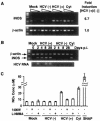
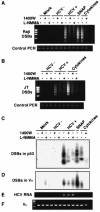
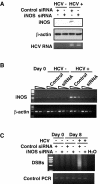
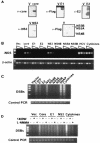


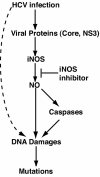
Similar articles
-
Hepatitis C virus core protein transactivates the inducible nitric oxide synthase promoter via NF-kappaB activation.Antiviral Res. 2003 Oct;60(2):117-24. doi: 10.1016/j.antiviral.2003.08.006. Antiviral Res. 2003. PMID: 14638407
-
Hepatitis C virus triggers mitochondrial permeability transition with production of reactive oxygen species, leading to DNA damage and STAT3 activation.J Virol. 2006 Jul;80(14):7199-207. doi: 10.1128/JVI.00321-06. J Virol. 2006. PMID: 16809325 Free PMC article.
-
c-Jun mediates hepatitis C virus hepatocarcinogenesis through signal transducer and activator of transcription 3 and nitric oxide-dependent impairment of oxidative DNA repair.Hepatology. 2010 Aug;52(2):480-92. doi: 10.1002/hep.23697. Hepatology. 2010. Retraction in: Hepatology. 2025 Jun 1;81(6):E181. doi: 10.1097/HEP.0000000000001226. PMID: 20683948 Free PMC article. Retracted.
-
Nitric oxide and chronic HCV and HIV infections.Dig Dis Sci. 2001 May;46(5):1072-6. doi: 10.1023/a:1010770230422. Dig Dis Sci. 2001. PMID: 11341651
-
Inducible nitric oxide synthase in the liver: regulation and function.Biochemistry (Mosc). 1998 Jul;63(7):766-81. Biochemistry (Mosc). 1998. PMID: 9721329 Review.
Cited by
-
The use of whey protein concentrate in management of chronic hepatitis C virus - a pilot study.Arch Med Sci. 2010 Oct;6(5):748-55. doi: 10.5114/aoms.2010.17091. Epub 2010 Oct 26. Arch Med Sci. 2010. PMID: 22419935 Free PMC article.
-
A pre-neoplastic epigenetic field defect in HCV-infected liver at transcription factor binding sites and polycomb targets.Oncogene. 2017 Apr 6;36(14):2030-2044. doi: 10.1038/onc.2016.340. Epub 2016 Oct 10. Oncogene. 2017. PMID: 27721404 Free PMC article.
-
Role of hepatitis C virus in B cell lymphoproliferations.Virol Sin. 2014 Feb;29(1):3-6. doi: 10.1007/s12250-014-3414-1. Virol Sin. 2014. PMID: 24452541 Free PMC article. Review. No abstract available.
-
Oxidative Stress-Related Mechanisms in SARS-CoV-2 Infections.Oxid Med Cell Longev. 2022 Mar 8;2022:5589089. doi: 10.1155/2022/5589089. eCollection 2022. Oxid Med Cell Longev. 2022. PMID: 35281470 Free PMC article. Review.
-
Nitric oxide in dengue and dengue haemorrhagic fever: necessity or nuisance?FEMS Immunol Med Microbiol. 2009 Jun;56(1):9-24. doi: 10.1111/j.1574-695X.2009.00544.x. Epub 2009 Feb 23. FEMS Immunol Med Microbiol. 2009. PMID: 19239490 Free PMC article. Review.
References
-
- Adamson, D. C., B. Wildemann, M. Sasaki, J. D. Glass, J. C. McArthur, V. I. Christov, T. M. Dawson, and V. L. Dawson. 1996. Immunologic NO synthase: elevation in severe AIDS dementia and induction by HIV-1 gp41. Science 274:1917-1921. - PubMed
-
- Ding, Y., and R. S. Rana. 1998. Nitric oxide does not initiate but potentiates glucose-induced insulin secretion in pancreatic beta-cells. Biochem. Biophys. Res. Commun. 251:699-703. - PubMed
-
- Elbashir, S. M., J. Harborth, W. Lendeckel, A. Yalcin, K. Weber, and T. Tuschl. 2001. Duplexes of 21-nucleotide RNAs mediate RNA interference in cultured mammalian cells. Nature 411:494-498. - PubMed
Publication types
MeSH terms
Substances
Associated data
- Actions
Grants and funding
LinkOut - more resources
Full Text Sources
Other Literature Sources

